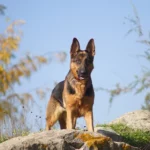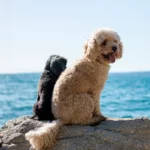Say hello to the Golden Retriever: a friendly, active dog with a shiny coat. They started as helpers for hunters in Scotland, and now they love any game that involves bringing things back.
Golden Retrievers: Loyal Friends
- They love being with people and are great with kids.
- They learn quickly and like to please, which makes training fun.
- They need exercise, so they’re great for families who like to be outside.
Keeping Up with a Golden
Golden Retrievers are happiest when they’re moving. They’ll join you for a walk or a game of catch and are always ready for action.
Bringing a Golden Retriever home will add a bundle of energy and cheer to your life.
This table provides a detailed profile of the Golden Retriever breed.
| Category | Detail |
|---|---|
| Breed Name | Golden Retriever |
| Origin | Scotland, United Kingdom, late 19th century |
| Breed Group | Sporting |
| Size Classification | Large |
| Weight Range | Males: 65-75 lbs (29-34 kg), Females: 55-65 lbs (25-29 kg) |
| Height Range | Males: 23-24 inches (58-61 cm), Femiles: 21.5-22.5 inches (55-57 cm) |
| Life Expectancy | 10-12 years |
| Coat Type | Dense, water-repellent outer coat with a thick undercoat |
| Coat Colors and Markings | Various shades of gold or cream |
| Grooming Needs | Moderate; regular brushing to prevent matting and reduce shedding |
| Shedding | Moderate to heavy, especially in spring and fall |
| Temperament | Friendly, reliable, trustworthy |
| Behavioral Tendencies | Enjoys retrieving games, gentle mouth, sociable |
| Social/Behavioral Traits | Excellent with children and other animals, highly social |
| Activity Level | High; thrives on exercise and play |
| Trainability | High; known for obedience and trainability |
| Intelligence Level | Very intelligent and eager to please |
| Barking Tendency | Moderate; may bark at strangers but not excessively |
| Health Issues | Hip dysplasia, elbow dysplasia, certain cancers, heart diseases |
| Dietary Needs | Balanced diet tailored to their exercise level; prone to weight gain |
| Suitability for | Families, active singles and seniors, search and rescue, service roles |
| Breed History | Bred for retrieving waterfowl during hunting and shooting parties |
| Exercise Requirements | Daily exercise, including walks and off-leash play in a secure area |
| Space Requirements | Does best with a yard but can adapt to apartment living with adequate exercise |
| Sleeping Requirements | Typically 10-12 hours a day, including naps |
| Climate Adaptability | Good in both cold and warm weather, but should not be left outside in extreme temperatures |
| Travel and Relocation Considerations | Adaptable to new environments; enjoys being with their family and can handle travel well |
| Compatibility Scorecard | City Living: 3/5, Families: 5/5, Novice Owners: 5/5, Exercise Enthusiasts: 5/5 |
| Ancestry and Bloodlines | Descended from the now-extinct Tweed Water Spaniel, crossed with the Yellow Retriever and other breeds |
| Notable Traits | Affectionate nature, lustrous golden coat, strong swimming ability |
| Role | Family companion, service and therapy work, search and rescue, competitive obedience |
| Care Requirements | Regular exercise, mental stimulation, consistent training, and companionship |
| Cost Breakdown | Food: $40-$70/month, Grooming: $50-$100/visit, Veterinary care: $300-$700/year, Training: $100-$200/course, Insurance: $30-$60/month |
| Training and Socialization | Requires early socialization and positive reinforcement training methods |
| Time Commitment | Several hours per day for exercise, play, and companionship |
| Enrichment Activities | Fetch, swimming, hiking, agility, puzzle toys |
| Common Training Mistakes | Not providing enough exercise, inconsistent training, not starting socialization early |
| Seasonal Care | Extra grooming during shedding seasons, protection from heat in summer |
| Allergy Considerations | Not hypoallergenic; sheds fur and dander |
| Health Screening | Hip and elbow evaluation, cardiac exam, ophthalmologist evaluation recommended |
| Insurance Recommendations | Coverage for breed-specific conditions and potential health issues |
| Mental Stimulation Needs | High; enjoys learning and can become bored without proper stimulation |
| Kennel Club Recognitions | AKC, UKC, CKC, and others |
| Breed Standards | Symmetrical, balanced, active, powerful, with a kind expression |
| Litter Size | 6-10 puppies |
| Level of Protection | Low to moderate; friendly disposition but can be a deterrent |
| Participation in Dog Sports | Often excels in obedience, tracking, agility, and retriever field events |
| Noise Level | Generally not noisy; may have a tendency to vocalize when excited or alerting to strangers |
| Odor Level | Low; regular grooming helps to keep any doggy smell at bay |
| Watchdog/Alarm | Moderate; will alert to strangers but not aggressive |
| Therapeutic Use | Widely used in therapy settings due to their gentle and intuitive nature |
| Cultural Significance | Popular in media, known for their roles as family pets and assistance dogs |
| Rescue Organizations | Golden Retriever Rescue of the Rockies, Golden Retriever Foundation |
| Certification and Testing | Recommended to have genetic testing for common conditions and certifications for hips, elbows, heart, and eyes |
| FAQ Section | Q: Are Golden Retrievers good for allergy sufferers? A: No, they shed and produce dander. Q: How often should a Golden Retriever be groomed? A: Weekly brushing; more often during shedding seasons. Q: Can Golden Retrievers live in hot climates? A: They can, but they should be kept cool and have access to water, especially in extreme heat. |


